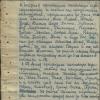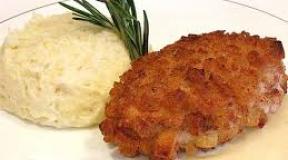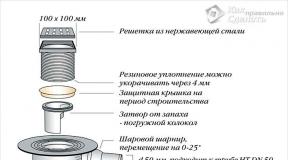Classification of methods for producing artificial cold. Physical basis for obtaining artificial cold. How air conditioners handle the cold
Send your good work in the knowledge base is simple. Use the form below
Students, graduate students, young scientists who use the knowledge base in their studies and work will be very grateful to you.
Posted on http://www.allbest.ru/
Topic: "Physical processes and technical means of obtaining artificial cold at the enterprises of the agro-industrial complex"
1. PHYSICAL PRINCIPLES OF OBTAINING ARTIFICIAL COLD
Artificial cold is an integral part of the technological processes of perishable products, their subsequent preservation, transportation and sale.
Artificial cooling is the removal of heat from a body that has a temperature lower than that environment, in which the cooled body is located.
The use of artificial cold to preserve perishable food found its application back in the 19th century, mainly in fisheries. The production of artificial cold was based on physical processes that are accompanied by heat absorption. Sometimes mechanical work or electricity is used for these purposes.
There are a number of such processes that are accompanied by the absorption of heat from the outside. These include the phase transition of a substance, namely:
Melting;
Evaporation;
Sublimation (dry pre-distillation, sublimation - or the direct transition of a substance when heated from a solid to a gaseous state, bypassing the liquid stage);
Adiabatic throttling (expansion of gas passing through a narrowed hole without performing external work and without heat exchange with the environment - the Joule-Thomson effect);
This effect is due to the expenditure of internal energy to work against the forces of molecular attraction, which leads to a change in the temperature of the real gas. It is used in the deep cooling technique. In refrigeration machines of the agro-industrial complex, this method is used extremely rarely.
Adiabatic expansion of gas with the performance of useful external work;
Vortex effect (Ranque effect), which consists in the fact that compressed air at the ambient temperature is fed into the pipe through the tangential inlet;
The thermoelectric effect (Peltier effect) consists in the fact that when a constant electric current passes through a circuit consisting of two dissimilar metals, one of them has a lower temperature, the other has a higher one. The cold junction is a source of low temperature. Thermoelectric cooling devices work according to this principle.
To preserve perishable foodstuffs, they must be constantly refrigerated. This is possible in the event that there is a large supply of refrigerant, or with its final amount, restore its original state, i.e. the refrigerant must perform a circular process or cycle, undergoing a number of changes, but it must necessarily turn into its original state. For this purpose it is necessary to expend external work.
2.thermodynamic processes and cycles refrigeration units
An ideal cycle for obtaining artificial cold can be a refrigeration unit operating in accordance with the reverse Carnot cycle, the essence of which is as follows. In contrast to the direct cycle, in which work is carried out during the transition of heat from a more heated body to a less heated one, in the reverse cycle, work or heat is transferred from a less heated body to a more heated one. On the diagram, this phenomenon (process) can be represented as follows.
As can be seen from the diagram, in process 1 - 2 the refrigerant is adiabatically compressed from volume V1 to volume V2 with an increase in temperature from T2 to T1. Further, in process 2 - 3, the refrigerant is compressed with simultaneous isothermal removal of heat Q1 at temperature T1 into the environment. In process 3 - 4, the refrigerant expands adiabatically from volume V3 to volume V4 with decreasing temperature from T1 to T2. In process 4 - 1, the refrigerant continues to increase in volume (expand) at temperature T2, isothermally receiving heat Q2 from a colder body relative to the external environment.
Ideal Chiller Cycle
S - entropy, i.e. the amount of energy that is transferred as heat from one body to another (Claudisus, 1852)
Q - heat reserve
T - absolute temperature
Actual chiller cycle
1-2 - adiabat (S = const) - compression of dry vapors in the chamber. Process 2-2 "- cooling of freon in a condenser (P = const), removes the previously received heat to the environment.
2 "-3 - compressed freon at T = const and P = const condenses in the condenser.
3-3 "- subcooling in the heat exchanger is isobaric. P = const.
3 "-4 - expansion after expansion valve (isenthalp, i = const.
4 -1 - boiling in the evaporator (T = const, P = const).
1-2 - adiabatic compression in the compressor up to pressure P1.
The beneficial effect of the refrigeration cycle is the amount of heat Q2, which is taken by the refrigerant from the cooled product, which has a temperature of T2.< Т1. Это количество теплоты принято называть холодопроизводительностью цикла, которую можно определить по формуле:
where i1 is the enthalpy of dry vapor of the refrigerant;
i4 - enthalpy of liquid refrigerant at subcooling temperature;
Сср - average heat capacity of the refrigerant at Р = const.
To assess the operation of a refrigerating machine operating on the reverse Carnot cycle, the refrigeration coefficient is used, which is defined as the ratio of the useful amount of heat taken from a refrigerating source of limited dimensions to the work expended on the cycle, where Aobr is the work spent on the reverse cycle.
To carry out such a cycle, it is necessary to install an additional forced-action expander - a dendrater in the working circuit of the refrigerating machine. This leads to additional energy consumption.
In existing refrigeration plants, instead of an expansion cylinder (expander), a throttling valve is installed, through which the refrigerant with pre-cooling passes. This is to increase the amount of boiling refrigerant in the evaporator, which will result in a shorter chiller cycle. Moreover, this cycle is accompanied by overheating of vapors during compression.
The working process of the chiller can be represented as the following diagram. Liquid freon boils in the evaporator at T = const and P2 = const (process 4-1 - isobar, isotherm), receiving heat Q2, which removes it from the cooled body.
The formed steam, passing through the heat exchanger, enters the compressor, where it is adiabatically compressed to the pressure P1 (process 1-2). Compressed and superheated
vapors from the compressor enter the condenser, in which at constant pressure P1 they are cooled (process 2-2 ") with simultaneous isobaric removal of heat Q1 obtained in previous processes in the environment. it is cooled to a lower temperature by refrigerant vapors leaving the evaporator or by water, the pressure P1 = const, and the temperature is lower than the condensation temperature T1 (process 2 "-3 isobars). From the heat exchanger, the refrigerant is fed to the filter drier, passing through which it enters the expansion valve. Throttling, the refrigerant adiabatically expands to pressure P2 (process 3-4 isenthalp i = const) with a decrease in temperature from T1 to T2. Then the process is repeated.
There are compression refrigeration machines in which the refrigeration act is compressed; heat-using refrigerating machines that consume heat energy; thermoelectric refrigeration machines based on the use of the Peltier phenomenon.
Compression refrigeration machines, in turn, are subdivided into gas, in which the gaseous refrigerant does not change the state of aggregation, and into steam, in which the refrigerant changes the state of aggregation (vapor - liquid). The latter are the most widespread.
Heat-using refrigeration machines are subdivided into absorption refrigeration machines, in which two components are involved in the refrigeration cycle - a refrigerant and an absorber (absorbent), and steam ejector, in which steam is compressed using a steam ejector.
Refrigerating agent or coolant is a working substance of a refrigerating machine. Different refrigerants are used depending on the type of chiller. So, in steam compression refrigerating machines, freons, ammonia, hydrocarbons (propane, ethane, ethylene, and other substances) are used as refrigerants; in absorption - aqueous solutions of ammonia and lithium bromide; in steam ejectors - water vapor.
Let us consider the schemes and principles of operation of compression steam, heat-insulating absorption and heat-using ejector refrigerating machines.
Fig. 1. Compression Refrigeration Machine Working Principle
A diagram of a compression refrigeration machine is shown in Fig. 1. It consists of the following main elements: evaporator 2, compressor 3, condenser 6, heat exchanger 9, filter-drier 11 and thermostatic valve TRV 10, connected by pipelines into a closed hermetic system filled with refrigerant.
The evaporator contains an intermediate heat carrier (water) located in the cold accumulator 1 as a result of heat exchange with a boiling refrigerant. The boiling of the refrigerant in the evaporator occurs due to throttling in the expansion valve and low pressure maintained by the compressor. The boiling point of the refrigerant in the evaporator is usually 5-150 lower than the temperature of the medium to be cooled. Through the surface of the evaporator, the water gives up its heat to the refrigerant, which turns into steam. Thus, in the evaporator, the refrigerant boils at a low temperature, taking heat from the cooled water.
The compressor draws refrigerant vapors from the evaporator and maintains a low pressure in the evaporator for a low boiling point. In addition, the compressor pumps the vapors into the condenser and compresses them to such a high pressure that they turn into liquid, provided they are cooled by the environment with a temperature of 20-300C.
The condenser provides cooling of compressed refrigerant vapors with ambient air in order to lower the vapor temperature to the condensation temperature (saturation state) and condensation of saturated vapors into a liquid state.
The receiver creates a supply of liquid refrigerant necessary to ensure an even supply of refrigerant to the evaporator system. In addition, the receiver is an additional capacity of the condenser, which prevents the condenser from overflowing with liquid refrigerant. The receiver of a working refrigeration machine must be filled with liquid refrigerant to 50% of its volume.
The heat exchanger provides subcooling of the liquid refrigerant going to the expansion valve and superheating of the vaporous refrigerant coming from the evaporator to the compressor.
The filter drier traps various mechanical impurities (sawdust, rust, etc.) of the refrigerant and absorbs the moisture in the system.
The thermostatic expansion valve is designed for throttling the liquid refrigerant entering the evaporator and regulating its flow rate. The throttling is accompanied by a decrease in the refrigerant pressure from the condensing pressure to the evaporating pressure. In addition, the thermoregulatory valve ensures the necessary filling of the evaporator with a liquid refrigerant, supplying as much liquid per unit of time as the vapors have time to suck out the compressor during this time.
Thus, the chiller operates in a closed cycle. The process of throttling of a liquid refrigerant with a thermostatic expansion valve (TRV) is accompanied by a change in the state of aggregation of the refrigerant. Part of the liquid passing through the expansion valve turns into saturated steam, while cooling the rest of the refrigerant to the boiling point. Therefore, a mixture of liquid and saturated steam (wet steam) comes out of the expansion valve. The relative content of steam in this mixture is 10-20% by weight or up to 90-95% by volume. The wet vapor entering the evaporator is separated into liquid and gaseous phases. The liquid in the evaporator boils at the boiling pressure, absorbing heat from the intermediate heat carrier (water) through the walls of the evaporator. The vapors coming from the expansion valve and formed during boiling are sucked off by the compressor. Evaporating temperature and pressure depend on the required cooling temperature, the size of the heat transfer surface of the evaporator and the intensity of heat transfer.
Refrigerant vapors sucked out by the compressor, as they move along the evaporator, as a result of heat exchange through the walls of the latter, are additionally heated. Therefore, their temperature at the outlet of the evaporator is usually 2-70C higher than the boiling point.
Compression of refrigerant vapors in a compressor from the evaporating pressure to the condensing pressure is accompanied by an increase in their internal energy, pressure and temperature. The temperature of the end of vapor compression in the compressor depends on the pressure difference at the inlet and outlet of the compressor and reaches 60-800C.
In the condenser, three processes take place sequentially: cooling of compressed vapors to saturation, their condensation, and supercooling of the liquid refrigerant. The condensing pressure and temperature depend on the temperature of the cooling medium, the size of the heat transfer surface of the condenser and the rate of heat transfer. As a rule, the condensing temperature is 5-200C higher than the temperature of the cooling medium.
The liquid refrigerant from the condenser through the receiver, heat exchanger and filter drier enters the expansion valve and the cycle is repeated. Thus, the refrigerating agent, moving in a closed cycle, removes heat from the water in the cold accumulator and gives it to the air that blows over the condenser.
Absorption chiller
In a heat-using absorption refrigeration machine (AXM), an absorber, a vessel filled with water, serves to remove steam from the evaporator. Ammonia vapors (refrigerant R717) from the evaporator I enter the absorber AB. The water through which ammonia vapor is bubbled dissolves (absorbs, i.e. absorbs). A slight decrease in pressure in the absorber promotes the entry of new vapors from the evaporator into the absorber.
When ammonia dissolves in water, heat is released, which worsens the further dissolution of ammonia. Therefore, the absorber must be cooled.
Water saturated with ammonia (strong solution) is fed to generator G. Here, the strong solution is heated by hot steam passing through the coil gas burner). Ammonia vapors, formed when the strong solution is heated, from the generator enter the condenser Kd, where they are cooled with water and condensed. High-pressure liquid ammonia is throttled in the expansion valve and enters the evaporator, where it boils at low pressure, taking heat from the cooling media.
The weak ammonia solution remaining in the generator after boiling off the ammonia returns to the absorber and absorbs new portions of ammonia vapors coming from the evaporator.
Thus, unlike a compression machine, in an absorption machine, instead of a compressor, two devices (absorber and generator) are used, as well as a pump for supplying liquid, the power of which is about 10 times less than that of a compressor.
In home absorption refrigerators, the 2PB pump and valve are generally excluded from the circuit. This is achieved by adding hydrogen to the evaporator. As a result, the pressure in the condenser becomes equal to the total pressure of ammonia and hydrogen in the evaporator. In this case, the addition of hydrogen does not affect the boiling point of ammonia in the evaporator, since it is determined only by the partial pressure of ammonia vapors.
Cooling coefficient
in absorption machines e? three times less than in compression. The absence of a compressor, which generates noises during operation, breaks down faster than heat exchangers, necessitates the use of absorption machines for household refrigerators as well.
However, in comparison with compression refrigeration machines, absorption refrigerators have a number of disadvantages. Since the heater is permanently or cyclically connected to the power grid, the operation of absorption chillers is more expensive than compression chillers that are periodically connected to the grid. The performance of absorption refrigeration machines is much lower than compression refrigeration machines, the process of cooling and obtaining a low (minus) temperature in absorption refrigeration machines is much slower and the temperature reached is much higher than in compression refrigeration machines.
Refrigerators of the absorption type (AT) are widespread in everyday life. They got their name from the absorption processes taking place in them, i.e. absorption by a liquid or solid scavenger of refrigerant vapors generated in the evaporator. The refrigerant is ammonia. Ammonia vapors are absorbed by water with the formation of a water-ammonia solution.
The components of the solution for filling the refrigeration unit are: refrigerant - ammonia, absorbent - water bidistillate, inhibitor - sodium chromate Na2CrO4, inert gas - hydrogen. The amount of ammonia-water solution for filling the refrigeration unit is 350-750 cm3, the ammonia concentration in the ammonia-water solution is 34-36% (by weight).
The unit is filled with ammonia water and hydrogen at a pressure of 1.47-1.96 MPa. Hydrogen is inert and does not react chemically with ammonia.
The purpose of hydrogen is to create a back pressure to the ammonia vapor. Hydrogen is fed into the condenser at a lower pressure than the pressure of the ammonia vapor before it condenses.
To protect the inner surface of the refrigeration unit pipes from corrosion, sodium chromate (Na2CrO4) is introduced into the solution in an amount of? 2% of the mass of the charge. Ammonia water solution is prepared by mixing ammonia with double distilled water.
The refrigeration unit is located on the rear wall of the refrigerator cabinet, the evaporator is located inside the refrigerator compartment.
The cooling capacity of the absorption-diffusion unit is 20-30 kcal / h.
Refrigeration unit
Rice. Refrigeration unit of absorption type
1 - boiler; 2 - reflux condenser; 3 - capacitor;
4 - evaporator; 5 - absorber; 6 - capillary tube Ø 0.8 mm
The absorption-diffusion refrigeration unit is made of seamless gas-welded pipes. The main components of the unit:
generator - production of ammonia vapor and the rise of a weak solution to the height of the discharge into the absorber;
condenser - condensation of ammonia vapors;
evaporator - evaporation of liquid ammonia with the formation of cold;
absorber - absorption of ammonia vapor by ammonia-water solution (absorption process);
electric heater - heating the ammonia-water solution in the generator.
The principle of operation of an absorption-type refrigeration unit is as follows. The concentrated solution is constantly heated in the boiler 1 to the boiling point by any heat source (electric, gas, etc.). Since the boiling point of the refrigerant is significantly lower than the boiling point of the solvent (absorbent), then during the evaporation of the concentrated solution (approximately t = 165-1750C), concentrated refrigerant vapors with a small amount of solvent leave the boiler. On the way to the condenser, concentrated refrigerant vapors pass through a special heat exchanger (reflux condenser 2), in which the concentrated vapors partially condense. In this case, the formed condensate flows into a weak solution leaving the boiler, and more concentrated refrigerant vapors enter the condenser 3. The highly concentrated liquid refrigerant flows through the capillary tube Ø 0.8 mm from the condenser to the evaporator 4, where it boils at a negative temperature, taking heat from the refrigerating chamber. A weak solution from the boiler enters the absorber 5 and is cooled by the environment to the temperature of the beginning of absorption. Refrigerant vapors leaving the evaporator also enter the absorber towards the moving cooled weak solution. In the absorber, the process of absorption (absorption) of refrigerant vapors by a weak solution takes place. In this case, a certain amount of heat of absorption (mixing) is released into the environment. The concentrated solution formed in the absorber is fed into the boiler with a thermal pump.
The circulation of the solution and the refrigerant is carried out continuously, while the boiler and the thermal pump, heated by the same heat source, are running. Thus, in a continuous absorption refrigeration unit, the role of the suction part of the mechanical compressor is performed by the absorber, and the discharge part is played by the thermal pump.
The Russian industry produces absorption refrigeration units: Morozko 3m, 4m, 5m; Ladoga 40m; Satellite ASh-60, Crystal 4, 9.9 m, 12 m; Hoarfrost, Russia. The cost of such units is much cheaper, but there is no warranty service and repair in our republic.
In a steam jet refrigeration machine, the working steam from the boiler (steam generator) enters the ejector nozzle, where it expands and, leaving the nozzle at high speed, injects (captures) cold steam from the evaporator. The total flow enters the condenser, where the pressure Pk is created.
Steam jet refrigeration machine diagram
1 - boiler; 2 - ejector; 3 - evaporator; 4 - cooling facilities; 5, 7 - pumps;
6 - capacitor.
From the condenser, the main part of the liquid is returned to the boiler by the pump, and the smaller part enters the evaporator through the PB1 control valve. Due to the operation of the ejector, a low pressure P0 is maintained in it, at which part of the water evaporates, the vapors are sucked off by the ejector, and the bulk is cooled and pumped to the objects to be cooled. Water returns to the evaporator through the PB2 control valve.
In terms of energy indicators, steam ejection machines are inferior to compression ones, but the simplicity of their design and maintenance, low initial cost, high reliability and the possibility of using low-potential heat make their use in certain conditions preferable.
Working substances of refrigeration machines, their main properties and scope
The working substance, with the help of which the reverse circular cycle occurs in the refrigerating machine, is called the refrigerant. Refrigerants are used in refrigerators, air conditioners and heat pumps. The most common heat agents are water, ammonia, freons, and air.
Depending on the used cooling agent, refrigeration machines are divided into two groups: steam and gas.
There are two types of steam engines - compression and absorption. In machines of the first type, the refrigerant is circulated by a compressor. In the second type, circulation is provided by the thermal energy of the heat heater when it heats up liquefied gas.
Gas engines use air as a refrigerant.
In air conditioners, water is used as a refrigerant, because the coolant temperature is always more than 00С (t> 00С).
Water is used as a refrigerant and in absorption and ejector types.
Ammonia is used in special absorption plants at boiling point tc> -700C. Its main advantages:
Small specific volume at evaporation temperatures;
High heat of vaporization;
Slight oil solubility;
Does not have a coordinating effect on steel.
The disadvantages include its toxicity, flammability, as well as explosiveness at a concentration in the air of 16 ... 26.8%. When mixed with water, it corrodes zinc, copper, bronze and other copper alloys, with the exception of phosphorous bronze. Therefore, carbon or hydrocarbon compounds containing fluorine, chlorine and bromine have become more widespread as refrigerants. This has improved the reliability, energy efficiency and safety of chillers. Initially, such halogenated derivatives of saturated hydrocarbons were called freons due to the fact that the American trading company "DuPont" in 1928 synthesized freon-12 for the first time. Currently, instead of the term "freon", the term "freon" has been introduced. The designation of freons according to the international standard MS ISO 817-74 is built according to the formula R - N (where R is a symbol denoting a refrigerant; N is a freon number or an assigned number for other refrigerants). For freons, the number is deciphered in the following order.
The first digit in a two-digit number or the first two or first two digits in a three-digit number designate the saturated hydrocarbon CnH2n + 2, on the basis of which freon is obtained. The following figures have been established: 1 - CH4 (methane); 11 - C2H6 (ethane); 21 - C3H8 (propane); 31 - C4H10 (butane), etc. Halide compounds of saturated hydrocarbons CnH2n + 2, obtained by replacing hydrogen atoms with fluorine, chlorine, and bromine atoms (CnHxFyClzBru), are extremely numerous. The number of molecules of individual constituents included in these chemical compounds are related by the relationship x + y + z + u = 2n + 2.
On the right, write the number of fluorine atoms in freon CF2Cl2 - R12, C3F4Cl4 - R214, etc. If there are bromine atoms in freon, the letter B is written after the main number, followed by the number of bromine atoms: CF2Br2 - R12B2. Unsubstituted hydrogen atoms - plus as many units as there are unsubstituted atoms left to the first digit (methane) or to the second in other compounds.
The main properties of refrigerants include thermophysical, physicochemical and physiological. Thermophysical properties include viscosity m, thermal conductivity l, density c, freezing point tcr, etc. m, l, s - they affect the heat transfer coefficient during boiling and condensation. Large values of l, s and low viscosity m correspond to large values of heat transfer coefficients. Viscosity and density affect the head resistance when the refrigerant circulates in the system. Physicochemical properties include solubility in lubricating oils and water, inertness to metals, explosiveness and flammability. In terms of physiological properties, refrigerants should not be toxic.
By the nature of interaction with oil, all refrigerants are divided into two groups. The first includes refrigerants with limited solubility in oil (ammonia R717, carbon dioxide R44, freons R13, R14, R115 are closely related); to the second group - with unlimited solubility (R11, R12, R21, R22, R40). This means that with limited solubility in the liquid phase of the mixture, two layers are observed, of which oil predominates in one, and refrigerant in the other. In the second case, this is not observed and, in addition, if it is not a pure refrigerant that boils, but a mixture (R12 + oil), then to obtain the same boiling point as for pure R12, it is necessary to maintain a lower boiling pressure and, therefore, to spend excessive work on steam compression.
In addition, the oil-cold mixture has a high viscosity. And this reduces the heat transfer coefficient. The solubility of freons in water also has essential for the normal operation of the chiller. Excessive moisture will cause ice to seal the throttling hole of the thermostatic valve.
The interaction of freons with metals also depends on their moisture content.
Halogenated hydrocarbons produce halogen acids with moisture, which can lead to hydrolysis of freon and corrosion of metals.
The refrigerant must not be explosive and poisonous, and must not ignite when mixed with air. However, ammonia is irritating to the eyes and upper respiratory tract. Its permissible concentration in the air is> 0.02 g / m3.
Freons with a high content of fluorine or completely fluorinated (R13, R113) are practically harmless to humans. R12 decomposes into its constituent parts only on an open flame. Its decomposition products contain phosgene. Lack of fluoride - ozone holes.
In what areas are the different refrigerants used?
Ammonia (R717), freons (R12, R22) are used in compression refrigeration machines to obtain boiling points up to -30 ... -400C without vacuum in the cooling system. R12 is used in single-stage refrigerating machines with tkond =< + 750С и tкип = >-300C, in home refrigerators, air conditioners, water-cooling refrigerators. R22 is used for machines with piston and screw compressors of one- and two-stage compression, as well as in household refrigerators. Range tboil = -10 ... 1700С, tkond =< 500С.
To reduce the solubility and circulation of oil, instead of R22, a mixture of R22 and R12 is used, as well as an azetropic mixture of R502.
R502 is used in low-temperature single-stage refrigerating machines at tkond =< 500С и tкип = >-450C, etc.
For practical use, the following refrigerants can be considered the most promising:
for high temperature refrigeration machines
Rkr / P0 R12 / R114; R22 / R114; R143 / R142
P0 - expansion pressure
for medium temperature
R22 / R114; R143 / R12; R13B1 / R12; R12 / R142; R22 / R12 / R142 / CO2
for low temperature
R13 / R12; R13B1 / R12; R13 / R22 / R12 / nitrogen.
Approximate designations and basic thermodynamic properties of the most common freons
According to the condensation pressure at the condensation temperature tк = 300С, refrigerants are divided into three groups:
1) high pressure refrigerants (2< Р30 < 7 МПа) или низкотемпературные (tн.к ниже -600С) - R744; R13; R14;
2) medium pressure refrigerants (0.3< Р30 < 2 МПа) или среднетемпературные (tн.к выше -600С и ниже -100С) - R717; R12; R22; R115; R143; R502;
3) low pressure refrigerants (P30< 0,3 МПа) или высокотемпературные (tн.к выше -100С).
By the type of refrigerant use, refrigeration machines are divided into ammonia, freon, propane, steam-water, ammonia-water, etc. In practice, more than twenty refrigerants are used.
Since in agriculture mainly compression refrigeration units are used, the rubbing parts of the compressor must be carefully lubricated. For lubrication, special lubricating oils are used, which retain their physicochemical properties without aging with the lowest possible pour point and high flash point. For this purpose, special refrigeration (refrigeration) oils of high quality, type HF, are used. In this case, each type of freon must correspond to its type of oil (R12 - HF 12-16; R22 -HF 22-24; R717 -XA; XA-23; XA-30; XA-34).
Oil aging occurs under the influence of oxygen in the air, as a result of which metal corrosion and the release of resinous substances occur, which lead to blockage of small passages in the refrigerator. Lubricating oils must be free of moisture. Therefore, they are released thoroughly dried, and stored in a hermetically sealed container. Before filling the refrigeration machine, the oil must be additionally dried.
Lubricating oils should have low cloud point and pour point. Turbidity occurs when the temperature drops due to the release of wax crystals from the oil. And this leads to blockage of small flow sections in the machine (capillary tubes) and disruption of the normal operation of the refrigerator.
ADDITIONAL LITERATURE
Refrigeration equipment. Ed. V.F. Lebedev. -M .: Agropromizdat, 2006.
AI Pobedinsky and others. Artificial cold at the enterprises of the agro-industrial complex. -Mn .: Urajay, 2004
...Similar documents
Physical basis for obtaining artificial cold. Refrigerating agents and intermediate refrigerants, their properties and requirements for them. Types of refrigerating machines and units, cooling systems, repair of installations and tasks of their operation.
test, added 03/29/2011
The use of cold in the confectionery industry. Optimal parameters cooling media for the production of sweets. Grouping of cold consumers by cold isotherms. Calculation of thermodynamic cycles of refrigeration machines. Refrigeration system diagram.
term paper, added 06/19/2011
Installation of refrigeration units: equipment with built-in hermetic machines, small units with remote units, units of medium and large capacity. Technique for safe work during the maintenance and operation of refrigeration units.
term paper, added 11/05/2009
Cooling systems for refrigerating chambers. The main ways to get cold. The device and principle of operation of the compression refrigeration machine. Refrigerating machines and units used in modern commercial activities. Their design and main types.
term paper, added 04/17/2010
Scope of refrigeration units. Maintenance of equipment, refrigeration and compressor machines and installations in accordance with technical drawings and documentation. Requirements for the individual characteristics of a specialist and professional training.
presentation added on 01/10/2012
Basic principles of aggregation of steam compressor refrigerating machines. Composition of compressor-condensing and compressor-evaporation units. Design features air condenser. Freezing bonnets, their types and scope.
abstract, added 09/11/2014
A characteristic of the main purpose of refrigeration technology, which allows you to preserve the properties of food products, as well as to obtain food products with new properties. The principle of operation of compression, absorption and steam jet refrigeration machines.
abstract, added 12/15/2010
History and current state of refrigeration evaporators. Quiet cooling chamber devices. Classification and designs of the main types of refrigeration evaporators. Quiet cooling chamber devices. Modernization of atmospheric evaporators.
term paper, added 10/12/2013
The role of refrigeration technologies in the food market. Characteristics of the construction area. Calculation of building areas for storage rooms and refrigerators. Selection of building and insulation structures and calculation of the thickness of thermal insulation. Equipment selection.
term paper, added 06/29/2012
History of creation and classification of absorption refrigeration machines; scope and use. Calculation of the cycle, generator, feed path of the initial mixture. Patent review of a multi-stage ejector machine and an absorption-diffusion unit.
Cold is obtained by removing heat from a gaseous, liquid or solid body. For example, they cool the air of chambers with food products, freeze water during production artificial ice or fish in the fisheries. In all these cases, heat is removed from the cooled body to the cooler or, as it is called, to the barrel body. This also applies to the simplest cases. For example, warm milk in cans is cooled in tanks with cold well water. The working fluid - the water in the tank - thus increases its temperature.
Lowering the temperature is also achieved by expanding the compressed gases. Of course, gas does not compress by itself. For this, a force must be applied from the outside, that is, the work must be done. The work expended on gas compression will turn into heat, the gas will heat up. Its particles will accelerate their movement. The pushes of particles against the walls of the vessel will become more frequent and strong, which means that the gas pressure will increase. Now let's give the compressed gas the opportunity to expand. Expanding, the gas will do the same work that was spent on its compression. This work can be done only due to the thermal energy of the gas itself. If, in this case, the gas is enclosed in a shell that does not conduct heat, so that there is no heat inflow from the outside, then the gas temperature will drop significantly. Thus, the expansion of the gas leads to its cooling.
This phenomenon is used in special gas refrigeration machines in which air serves as a working medium.
However, the methods of obtaining cold without changing the state of aggregation of the working fluid are not economical enough.
The best results are obtained when the working fluid changes its state of aggregation, that is, it passes from a solid state to a liquid or from a liquid to a vapor state. These changes in the cooler must take place at low temperatures and be accompanied by the absorption of a relatively large amount of heat from the medium to be cooled.
Each state of aggregation of the body corresponds to a certain temperature and pressure. With a change in the state of aggregation, the mutual arrangement of particles in the body also changes. This changes many of the physical properties of the body.
A change in the state of aggregation of a substance is accompanied by the release or absorption of latent heat, which is spent on the rearrangement of particles. Therefore, it occurs at a constant temperature, which depends on the physical properties of the substance and the conditions for its transition from one state to another.
If heat is continuously supplied to a solid, then at a certain temperature it will begin to pass into a liquid state, i.e., melt. An example of the melting of a solid used for cooling is the melting of ice.
What happens to ice particles when it melts?
Ice is a solid; its particles form, as we have already said, a crystal lattice. Large forces of attraction, or cohesion, act between ice particles. When the ice melts, the order in the arrangement
The particles are broken. They break loose from their places and come into a disorderly movement - a liquid is formed. In order to overcome the cohesion forces, that is, to destroy the crystal lattice, it is necessary to expend energy. This is where the heat supplied to the ice is spent.
Some solids, when melted, immediately turn into a vapor state. Such a change in the state of aggregation of matter is called sublimation, or sublimation. To obtain cold, sublimation of the so-called dry ice is used, with the properties of which we will get acquainted below.
Cooling based on the melting of ice from water or the sublimation of dry ice is called ice cooling.
In modern refrigeration technology, machine cooling is mainly used, and in some cases, ice and ice-salt cooling, and all these methods of obtaining cold are based on a change in the state of aggregation of matter.
What happens in the ice / salt mixture?
Two processes take place in it simultaneously: melting of ice and dissolution of salt. When dissolved, the salt passes from a solid state to a solution. This transition requires heat, which is spent on overcoming the forces of interaction between the salt particles. Therefore, the temperature of the resulting brine is lower than the temperatures of ice and salt taken separately. The mixture, consisting of four parts by weight of ice and five parts of calcium chloride, lowers the temperature to -40 ° C. But more often in the industry, ice-salt cooling is used, based on the use of a mixture crushed ice and common table salt. The temperature of the mixture depends on the amount of salt added to the ice. When 30 percent salt (by weight) is added to ice, the lowest temperature is reached - 21.2 ° C.
Ice and ice-salt cooling, based on a change in the aggregate state of the working fluid, are used in the food industry, in the retail network and in railway transport for the transportation of perishable goods.
Of great importance in refrigeration engineering is the machine method of obtaining cold, based on the phenomenon of evaporation of certain liquids at low temperatures. It is easy to be convinced that when the liquid evaporates, cooling occurs. Moisten your hand with water, and then, without wiping, wave it in the air. You will immediately feel that the hand has become colder. The water evaporates quickly and cools the skin of a wet hand.
Evaporation of liquid occurs in different ways. If the liquid turns into vapor only from the surface, then this is evaporation. If vaporization occurs not only from the surface of the liquid, but also inside it, then this is boiling.
Let's trace how water turns into steam when it is heated. At normal atmospheric pressure (760 mm Hg), the water temperature, gradually increasing, reaches + 100 ° C, and then remains constant, no matter how much we heat it. At the same time, the water boils.
The temperature of evaporation and boiling of a liquid depends on the pressure of the vapors formed above it. For example, on a very high mountain the air is more rarefied than at the foot, and, therefore, its pressure is lower than normal. Therefore, when heated, water here boils at temperatures below + 100 ° C. On the contrary, in a steam boiler, where the pressure is several times higher than normal, water boils at temperatures above + 100 ° C.
For the evaporation and boiling of a liquid, as well as for the melting of a solid, it is necessary to expend thermal energy.
This energy is spent on overcoming the cohesion forces between the particles of the liquid when it turns into steam. The amount of heat required to vaporize one kilogram of liquid depends on the vapor pressure and
Determined by the PHYSICAL PROPERTIES OF THE LIQUID. THIS IS KO "
The amount of heat energy is the heat of vaporization of a given liquid.
When heat is taken away from the vapors, they again turn into a liquid, that is, they condense.
People have been using cooling by evaporation for a long time. In ancient Egypt * for example, water was cooled this way.
Water seeped through the pores of the vessel and quickly evaporated in the outside air. To speed up the evaporation, the slaves set the air in motion with fans (Fig. 2).
Each of you can make the simplest refrigeration "machine" based on the evaporation of liquid. Wrap the jar with a tightly wet cloth butter and place it in a bowl of water (fig. 3). On a rag, the edges of which must be immersed in water, the water rises up, just as kerosene rises along a wick to the burner of a lamp. Due to the evaporation of water from a wet rag (if, moreover, this simple refrigerator is placed in a draft), the oil in the can will harden: the evaporation of water will cause the oil to cool.
Low temperatures in industry are obtained by the evaporation of some so-called volatile liquids with low boiling points. They serve as a working fluid in steam refrigeration machines.
 The first attempts to obtain deep cooling were made in the last century, when scientists first tried to turn some gases into liquid. Currently, any gas can be obtained in liquid form. For example, the air we breathe turns into a liquid, which has a temperature of about - 193 ° C.
The first attempts to obtain deep cooling were made in the last century, when scientists first tried to turn some gases into liquid. Currently, any gas can be obtained in liquid form. For example, the air we breathe turns into a liquid, which has a temperature of about - 193 ° C.
The simplest scheme for obtaining liquid air is shown in Figure 4.
The question involuntarily arises as to what the lowest body temperature can be obtained. Scientists have established that such a limiting temperature is a temperature of -273.16 ° C. At this temperature, the thermal movement of particles in the body should completely stop. Therefore, the temperature is -273.16 ° C and is taken as the absolute zero of the special temperature scale Kelvin (abbreviated K). Temperature readings on this scale can only be positive.
Air conditioners have been on the market for a long time, and over the past 10 years have become truly public. At the same time, not everyone knows the principle of their work. If we do not cool the street, then why do we need a block outside? How much outside air enters the room through the connecting pipes? Etc.
I bring to your attention a publicly available popular science informative story. And we will start from the very beginning - with getting cold.
How to get cold?
In the scientific world, this topic is called "The physical basis of obtaining cold." And more than a dozen of such bases are listed. But this is difficult and boring. Let's go the easy way. We need to get the cold in the room. How to do it?
- Create cold (cold energy) from some other energy.
- Bring cold from another room.
It seems that everything is simple for now - we always and everywhere have two options to acquire something - to do it ourselves or to steal it from someone.
For example, all electric heaters generate heat on their own. And if you blow hot summer air from the street with a fan, then here we do not create heat, but transfer it (from the street to the room). What is the effectiveness of both methods? In the first case, we spend exactly as much electricity as we receive heat (a heating element that consumes 1 kW gives exactly 1 kW of heat), i.e. The efficiency is 100%. In the second case, using a fan that consumes 1 kW from the street, you can catch up with 5, 10 and 20 kW of heat! The street would be hotter! And what? Will the efficiency be 500, 1000 or 2000%? Not at all, but the fact that the second method is more effective is obvious.
Air conditioners are cold carriers
The air conditioner works exactly in the second way. He does not create cold, but brings it from the street. How - we will see a little below, but for now one more comparison from modern life.
Consider the job of an engineer and a sales manager. An engineer is engaged in design and earns by developing and creating all kinds of equipment. He can spend a year or two on development. The manager transfers this technique, or rather resells it, earning a margin. And who lives better in our time? :)
So, back to the air conditioners. That is why they all consist of two blocks, what exactly! Transfer! cold. The first block is the sender of cold, the second is the recipient (or, in terms of heat, on the contrary: the first block is the recipient of heat, and the second is the sender). Addressee and addressee. The so-called outdoor and indoor units.
How do air conditioners handle the cold?
It's very simple - to implement the transfer process, you need some kind of carrier substance. In winter, it is cold outside and the carrier cools there, and heats up in the room, while cooling the air in the room. Those. the carrier transferred the temperature from the street to the room.
But where to get the cold in the summer heat? The answer is simple - from the same heat. You just need to approach the issue a little differently and transfer not temperature, but energy. If you transfer energy from the room to the street, then the energy in the house will remain less and it will become colder, while it will be warmer outside.
How does energy carrier matter transfer energy? Let us turn to the properties of substances at different pressures. For example, to the properties of air. If we take a certain volume of air at a temperature of 25 ° C and a pressure of 1 atm. (point 1, Fig. 1) and compress it to 200 atm (point 2), then its temperature will increase to 53 ° С. Now let's cool it down with street air to 40 ° С (point 3) and again bring it to a pressure of 1 atm (point 4), while it cools down to 8 ° С - here it is! Such a temperature can also cool the room! Actually, that's all - the task is completed!
The problem of choosing a coolant
The above method of obtaining cold using air finds its application in refrigeration technology to obtain temperatures of about -100C, but is absolutely not suitable for air conditioning:
- First, as we have seen, air as a heat carrier is inconvenient, because 200 atm. - very high pressure requiring high power consumption to achieve it.
- Secondly, and this can be shown, we need a large air flow.
- Finally, thirdly, any substance has a remarkable property to consume or give up energy without changing its own temperature. This happens when the state of aggregation changes. For example, if heating 1 kg of water at atmospheric pressure from 5C to 15C requires 42kJ of energy, from 15C to 25C - the same amount (the dependence of heat capacity on temperature can be neglected) and from 85C to 95C - all the same 42kJ, then from 95C to 105C - not at all. The secret is that at 100C the water will begin to boil and how much energy do not supply until everything boils away, we will not see further heating - all the joules supplied will go to change its state of aggregation. And the energy required to boil off 1 kg of water is amazingly great! This is as much as 2500kJ! In total, heating from 95C to 105C will cost us 2542kJ! Feel the difference 60 times? What does this mean in practice? This means that if it is necessary to transfer, for example, 25000 kJ at a temperature difference of 10C, then we will need 600 kg of water without changing its state of aggregation, or only 10 kg with a change. 60 times less! But, you will notice, temperatures of 95C and 105C can be used for heating, but not for getting cold. Indeed, it is so. But I note that our example was given for atmospheric pressure, and if the coolant water is taken at a lower pressure, then the boiling point will decrease. But in order for the water to boil at the desired 10C, an absolute pressure of about 0.02 ata is necessary - this is almost a vacuum - an extremely difficult condition to achieve.
The final conclusion is simple - it is necessary to find a convenient coolant - so that temperatures of the order of 10C are achieved at "reasonable" pressures, plus, if possible, the thermal effect is used when changing the state of aggregation.
The appearance of freons
This is how freons were born, often referred to as freons (in fact, it is more correct to use the term “freon”, and freon is just a patented freon from E. I. du Pont de Nemours and Co. (USA)). Let's follow the points that clarify their composition, assortment, specific properties, etc. - 30 atm) and together with all the advantages, the heat of vaporization and condensation is used.
So, modern air conditioners operate on freon, the compression of which is carried out in a compressor, the compressed gas is cooled, and at the same time it is converted into a liquid state in a heat exchanger-condenser, the cooled compressed freon expands in a throttle (or a thermostatic valve or in a capillary). As a result, it cools down and enters the heat exchanger-evaporator, where, giving cold to the room, heats up, evaporates and heats up again, flowing into the compressor. The cycle is closed.
Ways to get cold
The physical nature of heat and cold is the same, the difference is only in the speed of movement of molecules and an atom. In a more heated body, the speed of movement is greater than in a less heated one. When heat is supplied to the body, the movement increases; when heat is removed, it decreases.
Thermal energy is the internal energy of the movement of molecules and atoms.
Body cooling - this is the removal of heat from it, accompanied by a decrease in temperature. The simplest way of cooling is heat exchange between the cooled body and the environment - outside air, river sea water, soil.
But in this way, the temperature of the cooled body can be lowered only to the ambient temperature. This cooling is called natural cooling. Cooling the body below ambient temperature is called artificial. For it, they mainly use latent heat absorbed by bodies when their state of aggregation changes.
The amount of heator coldness is measured in calories or kilogram-calories (kilocalorie). A calorie is the amount of heat required to heat 1 g of water by 1 at normal atmospheric pressure, a kilocalorie is to heat 1 kg of water by 1C under the same conditions.
There are several ways to obtain artificial cold.
1.O cooling with ice or snow,melting of which is accompanied by the absorption of a fairly large amount of heat.Simple, cheap. The disadvantage is that you cannot get a temperature below +3 ° C. Practically in a room cooled by ice or snow, the air temperature can be maintained only at a level 5-8 ° C. Ice cooling uses water ice or solid carbon dioxide (dry ice).
At cooling with water icethere is a change in its state of aggregation - melting (melting). Cooling capacity, or the cooling capacity of the clean water ice, is called the specific heat of fusion. It is equal to 335 kJ / kg. The heat capacity of ice is 2.1 kJ / kg degree.
Water ice is used as a cooling agent in special glaciers and ice storage facilities. There are glaciers with bottom loading of ice (glacier-cellar) and with side - pocket type.
2. Ice-salt coolingmade using crushed water ice and salt. By adding salt, the rate of ice melting increases and the temperature at which the ice melts is lowered. This is because the addition of salt causes a weakening of molecular cohesion and destruction of the ice crystal lattices. Melting of the ice-salt mixture proceeds with the extraction of heat from the environment, as a result of which the ambient air cools and its temperature decreases. With an increase in the salt content in the ice-salt mixture, its melting point decreases. The salt solution with the lowest melting temperature is called eutectic, and its melting temperature is called the cryohydrate point. Cryohydrate point for ice-salt mixture with cooking salt -21.2 ° C, at a salt concentration in the solution of 23.1% with respect to the total mass of the mixture, which is approximately equal to 30 kg of salt per 100 kg of ice. With further salt concentration, there is not a decrease in the melting temperature of the ice-salt mixture, but an increase in the melting temperature (at a 25% salt concentration in the solution to the total mass, the melting temperature rises to -8° C).
When an aqueous solution of sodium chloride is frozen at a concentration corresponding to the cryohydrate point, a homogeneous mixture of ice crystals and salt is obtained, which is calledeutectic solid solution.
Melting point of the eutectic solid solution of sodium chloride -21.2° C, and the heat of fusion is 236 kJ / kg. The eutectic solution is used for zerotor cooling. For this into zeroths - tightly sealed forms - pour in a eutectic solution of sodium chloride and freeze them. Frozen grainsUsed to cool counters, cabinets, refrigerated portable cooler bags, etc.
3.Cooling with dry iceis based on the property of solid carbon dioxide to sublimate, i.e., when heat is absorbed, pass from solid state into a gaseous, bypassing the liquid state. Physical properties dry ice: sublimation temperature at atmospheric pressure - 78.9 ° C , heat of sublimation 574.6 kJ / kg. ... The high cost of dry ice limits its widespread use.
Dry ice has advantages over water ice:
1.Could get a lower temperature;
2.The cooling effect of 1 kg of dry ice is almost 2 times that of 1 kg of water ice:
3.When cooling, no dampness occurs, in addition, when dry ice is sublimated, gaseous carbon dioxide is formed, which is a preservative that contributes to better preservation of products.
Dry ice is used for transportation of frozen products, cooling of packaged ice cream, frozen fruits and vegetables.
Artificial cooling can also be achieved by mixing ice or snow with dilute acids.For example, a mixture of 7 parts of snow or ice and 4 parts of diluted nitric acid has a temperature of -35 ° C.Low temperatures can also be obtained by dissolving salts in dilute acids. So, if 5 parts of ammonium nitrate and 6 parts of sodium sulfate are dissolved in 4 parts of diluted nitric acid, then the mixture will have a temperature of -40° C.
Obtaining artificial cold with the help of snow or ice, as well as with the help of cooling mixtures, has significant drawbacks: the laboriousness of the processes of harvesting ice or snow, their delivery, the difficulty of automatic regulation, and limited temperature capabilities.
4. Cooling with liquid gases(nitrogen, air, etc.)based on their boiling at low temperature.At normal pressure, the boiling point of nitrogen is –195.8 ° С, air - from –190 to –195 ° С, oxygen –182.8 ° С.
In connection with the energy crisis, environmental pollution, the problem of using non-traditional environmentally friendly methods of obtaining cold for the refrigeration processing of food is becoming more and more urgent. The most promising of them is the cryogenic method based on liquid and gaseous nitrogen with the use of a machineless flow-through cooling system, which provides for a one-time use of a cryoagent.
Perspective this method refrigeration supply is increasing due to the discovery in Russia of large reserves (340 billion m3 3 ) underground high-nitrogen gases. The prime cost of purified nitrogen is an order of magnitude lower than nitrogen obtained using the air separation method.
Machineless flow-through nitrogen cooling systems have significant advantages: they are very reliable in operation and have a high freezing rate, which ensures almost complete preservation of the quality and appearance of the product, as well as minimal loss of its weight due to shrinkage.
The ecological purity of such systems should be especially noted (the Earth's atmosphere contains up to 78% of gaseous nitrogen).
The most simple in design and available are installations operating on ready-made refrigerants:water or dry ice, ice-salt mixtures, liquid gases and etc.The main disadvantage is the complete dependence on the possibilities and conditions for obtaining refrigerants, a large amount of work associated with charging the cooling system. Machine cooling, which consumes only energy or air from the outside, does not have this drawback.
The most common and operationally convenient cooling method is machine cooling.
5.Machine cooling- a method of obtaining cold by changing the state of aggregation of the refrigerant, boiling it at low temperatures with the removal of the necessary heat of vaporization from the cooled body or medium
Cooling, like heating, is based on heat exchange - it is a spontaneous transfer of heat from a body with a higher temperature to a body with a lower temperature. For cooling, processes are used that take place with the absorption of heat from the environment: melting or dissolution; boiling or evaporation; sublimation, etc.
Under low temperaturesunderstand temperatures below ambient. In the refrigeration equipment of trade and public catering enterprises, this range is from 0 to - 40 ° C.
Low temperatures are obtained as a result of physical processes that are accompanied by heat absorption. The main such processes include:
1.Phase transition of a substance - melting, boiling (evaporation), sublimation
Phase transition some substances during melting, boiling (evaporation), sublimation occurs at low temperatures and with absorption significant amount heat.
Fig. 1 Scheme of phase transitions of matter
Melting - transition of a solid to a liquid state at a certain temperature. Heat of fusion - the amount of heat required to convert 1 kg of a solid at a constant temperature into a liquid state.
Sublimation- transition of bodies from a solid state to a vapor state, bypassing the liquid phase.By the heat of sublimation- the amount of heat required to convert 1 kg of solid into steam at constant pressure and temperature. Solid carbon dioxide at atmospheric pressure turns into a gaseous state at -78 ° C.
Boiling - the process of converting a liquid into steam. Vapor formation occurs throughout the entire volume of the liquid. The temperature of the liquid heated to the boiling point remains constant at a constant pressure until everything boils away.
Evaporation- the process of converting a liquid that has not reached the boiling point into steam. Evaporation occurs only from the surface of the liquid.
In refrigeration technology, evaporation also means boiling.
The reverse process of boiling is condensation. Condensation takes place at a constant temperature and is accompanied by the release of heat. The condensing temperature depends on the pressure. Pressure and temperature always change in the same direction. The temperature rises, the pressure rises, and vice versa.
2.Adiabatic Gas Expansion
NS A process that takes place without the supply and removal of heat is called adiabatic. Adiabatic expansion is the process of a sharp drop in pressure when the working medium passes through a special expansion device. In refrigeration technology, an expander is used as an expansion device.
3. Throttling of gases and liquids
The process of a sharp drop in pressure (temperature) when the working substance passes through a local constriction in the channel.
 narrowing in the canal
narrowing in the canal
Rice. 2 Chiller diagram
4. Thermoelectric effect (Peltier effect)
A unit element of a thermoelectric module (TEM) is a thermocouple consisting of two dissimilar elements with p- and n-type conductivity. The elements are connected to each other using a copper connection plate. Semiconductors based on bismuth, tellurium, with impurities of antimony and selenium are used as the material of the elements.
TEM is a set of thermocouples electrically connected in series. Thermocouples are placed between two flat ceramic plates based on aluminum oxide or nitride. The number of thermocouples can vary over a wide range - from units to thousands of pairs, which makes it possible to create a TEM of almost any refrigerating capacity - from tenths to hundreds of watts.
When passing through the TEM constant electric current a temperature difference forms between its sides -one side (cold) is cooled, a the other (hot) heats up... If heat removal is provided from the hot side of the TEM, then on the cold side you can get a temperature that will be tens of degrees lower than the ambient temperature. The degree of cooling will be proportional to the amount of current. When the polarity of the current is reversed, the hot and cold sides of the Peltier element are reversed.
Fig.3 Action of the Peltier effect when current flows through p- and n-type semiconductors. | Fig. 4 Thermoelectric module ( TEM) | Fig. 5 Appearance TEM |
The highest thermoelectric efficiency for the manufacture of TEM materials is possessed bybismuth telluride, to which special impurities, selenium and antimony are added.
Thermoelectric refrigeratorsilent, but expensive:cooler bags, small car refrigeratorsand drinking water coolers.
Methods for obtaining artificial cold are varied.
The physical nature of heat and cold is the same, the difference is only in the speed of movement of molecules and atoms. In a more heated body, the speed of movement is greater than in a less heated one. When heat is supplied to the body, the movement increases; when heat is removed, it decreases. Thus, thermal energy is the internal energy of the movement of molecules and atoms.
Cooling the body is the removal of heat from it, accompanied by a decrease in temperature. The simplest way of cooling is heat exchange between the cooled body and the environment - outside air, water, soil. But in this way, even with the most perfect heat exchange, the temperature of the cooled body can be lowered only to the ambient temperature. This cooling is called natural cooling. Cooling the body below ambient temperature is called artificial. It uses latent heat absorbed by bodies when their state of aggregation changes.
There are several ways to obtain artificial cold. The simplest of these is cooling with ice, the melting of which is accompanied by the absorption of a fairly large amount of heat. If the heat gains from the outside are small, and the heat-transferring surface of the ice is relatively large, then the temperature in the room can be lowered to almost 0˚С. Practically in a room cooled with ice, the air temperature can be maintained only at the level of 5 -8 ˚С.
When cooled with water ice, there is a change in its state of aggregation - melting. The cooling capacity, or the cooling capacity of pure water ice, is called the specific heat of fusion. It is equal to 335 kJ / kg · degree.
Water ice is used for cooling and seasonal storage of food products, vegetables, fruits in climatic zones with a long cold period, where it can be easily prepared in natural conditions in winter.
Water ice is used as a cooling agent in special glaciers and ice storage facilities. There are glaciers with bottom loading of ice (glacier - cellar) and with side loading - pocket type.
Ice cooling has significant drawbacks: the storage temperature is limited by the ice melting temperature (usually the air temperature in ice warehouses is 5-8 ºС), it is necessary to put enough ice in the glacier for the entire storage period and add as needed, significant labor costs for the preparation and storage of water ice; large dimensions of the ice storage room, approximately 3 times the size of the food storage room; significant labor costs for compliance with the necessary requirements for the storage of food products and the removal of melt water.
Ice-salt cooling is performed using crushed water ice and salt. By adding salt, the rate of ice melting increases and the temperature at which the ice melts is lowered. This is because the addition of salt causes a weakening of molecular cohesion and destruction of the ice crystal lattices. The melting of the ice-salt mixture proceeds with the extraction of heat from the environment, as a result of which the ambient air cools and its temperature decreases. With an increase in the salt content in the ice-salt mixture, its melting point decreases. The salt solution with the lowest melting temperature is called eutectic, and its melting temperature is called the cryohydrate point. The cryohydrate point for an ice-salt mixture with table salt (Н 2 О - NaCl) is 21.2 ºС at a salt concentration in the solution of 23.1% relative to the total weight of the mixture, which is approximately equal to 30 kg of salt per 100 kg of ice. With a further increase in the salt concentration, there is not a decrease, but an increase in the melting temperature of the ice-salt mixture (Fig. 5.1).
Figure 5.1 - Dependence of the solidification temperature of the solution on the concentration of salt in water.
The eutectic solution is used for zerotor cooling. To do this, a eutectic solution of sodium chloride is poured into the zerotor - tightly sealed molds and frozen. Frozen zeros are used to cool counters, cabinets, refrigerated portable bags - refrigerators, etc.
Dry ice cooling is based on the sublimation property of solid carbon dioxide, i.e. when heat is absorbed, pass from a solid state to a gaseous state, bypassing the liquid state. The physical properties of dry ice are as follows: sublimation temperature at atmospheric pressure - 78.9 ° C, heat of sublimation 574.6 kJ / kg.
Dry ice has the following advantages over water ice:
A lower temperature can be obtained;
The cooling effect of 1 kg of dry ice is almost twice that of 1 kg of water ice;
When cooled, no dampness occurs, in addition, when dry ice is sublimated, gaseous carbon dioxide is formed, which is a preservative that contributes to better preservation of products.
Dry ice is used for transportation of frozen products, cooling of packaged ice cream, frozen fruits and vegetables. Dry ice is obtained artificially at carbon dioxide factories, it is stored in special containers with reinforced thermal insulation.
Obtaining artificial cold with the help of ice, as well as with the help of cooling mixtures, has significant drawbacks: the laboriousness of the processes of harvesting ice, its delivery, the difficulty of automatic regulation, and limited temperature capabilities.
Thermoelectric cooling is based on the Peltier effect (discovered by Jean Peltier in 1834), the essence of which is that under the influence of an electric current passing through a circuit of 2 different conductors or semiconductors, different temperatures appear on the junctions (Fig.5.2). If the cold junction temperature is lower than the ambient temperature, then it can be used as a cooler. A significant temperature difference at the junctions is given by pairs composed of semiconductors made from compounds of bismuth, antimony, selenium with the addition of a small amount of additives.
Figure 5.2 - Schematic diagram of thermoelectric cooling.
The advantage of thermoelectric cooling is the absence of moving parts, working fluid, noiselessness, reliability and durability of work, the disadvantage is high power consumption. Thermoelectric coolers are used in some types of refrigerated cabinets and refrigerated bars.
Considering the disadvantages of all the above cooling methods, the most common and operationally convenient cooling method is machine cooling.
Machine cooling is a method of obtaining cold by changing the state of aggregation of the refrigerant, boiling it at low temperatures with the removal of the necessary heat of vaporization from the cooled body or medium. For the subsequent condensation of refrigerant vapors, a preliminary increase in their pressure and temperature is required.
The widespread use of machine cooling in trade is explained by a number of its operational properties and economic advantages: automatic maintenance of a constant storage temperature depending on the type of product, a high proportion of the use of useful cooling capacity, low operating costs, Maintenance and renovation, ease of use and sanitization.
The complex of mechanisms and devices that carry out the refrigeration cycle is called a refrigeration machine. In trade enterprises, compression refrigeration machines are used, in which refrigerant vapors are compressed in a compressor using mechanical energy.
Read also ...
- Tankmen of the first day of the war: uniform and equipment (29 photos) Outfit of a Red Army soldier 1945
- Search for relatives who fought on the fronts of the great patriotic war
- Children's uniform of the executioners of the NKVD
- War diary of K. Ya. Nayakshin. Mukin Dementy Nikolaevich. Search for burial site 346 sd combat path



















